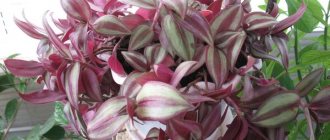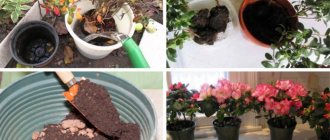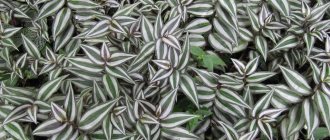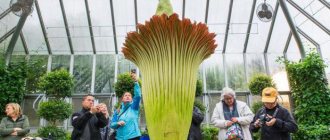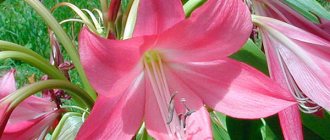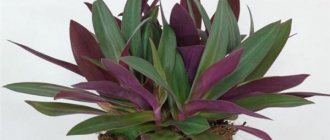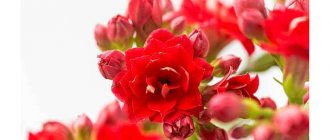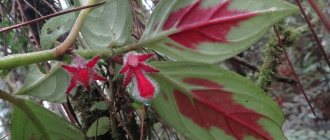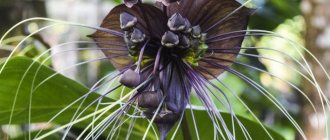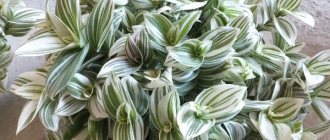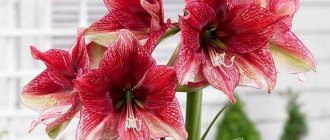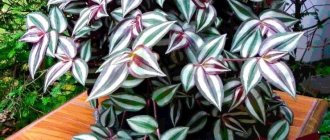Photo of the plant Tradescantia - a plant from Central and South America. It is a system of several straight or creeping shoots and saber-shaped leaves. Colors may vary: green, white, purple, blue, red, gray.
Life expectancy is high, 7-10 years. The plant belongs to the perennial type. However, over time it needs updating. The height of domestic tradescantia usually varies from 30 to 60 cm. Wild specimens can reach a meter in height. In a year, the plant can grow up to 30 cm.
Flowering period is summer months, mainly from July to August. In cultivation, the plant is beautifully flowering and decorative foliage.
| In a year, the plant can grow up to 30 cm. |
| It blooms in summer, mainly from July to August. In cultivation, the plant is beautifully flowering and decorative foliage. |
| The plant is easy to grow. |
| Perennial. |
Botanical description
Tradescantia (oysters, cradle lilies, spider lilies) belong to the Commelionaceae family and are classified as a separate genus consisting of 75 species. These are herbaceous perennials , the maximum height of which is 60 cm. The stems are most often creeping and thin.
They grow in groups or separately in fields and forests. The length, shape, and color of the foliage depend on the species (green or variegated). The surface of the plates may be pubescent.
The inflorescences are paniculate, the flowers (blue, violet, light blue, pink, white), consist of three petals and six stamens (sometimes four petals and eight stamens), close during the day in sunny weather. Each individual flower lives only one day , but the large number of buds ensures continuous flowering from spring to autumn. Tradescantia juice is clear and sticky.
The natural conditions of this plant are America (from Mexico to Canada). Species imported from the tropics are grown as indoor flowers. Suitable for open ground are varieties bred from Tradescantia growing in the north of the American continent, where they are called arachnids.
What kind of fertilizer can be used
The plant needs regular feeding: once every 14 days. You can use any type of complex fertilizer, which can be purchased at a simple flower shop.
It is also recommended to add 1 tbsp to the water for irrigation. a spoonful of liquid fertilizer.
What it looks like, what family it belongs to
Tradescantia is one of the most common indoor plants. Her flowers are small and modest. The fruits are small shaped capsules, each containing several seeds.
Tradescantia is grown in greenhouses and in open ground
The hanging plant is used for landscaping both brightly lit rooms and shaded rooms. Indoor Tradescantia looks good on high stands and in hanging flowerpots; it is used to decorate arches and niches. By combining different types, you can create hanging gardens, giving the indoor space a feeling of lightness and airiness.
Additional Information! Tsiolkovsky also spoke about the need to use plants on long flights to ensure breathing and nutrition for people. In 1960, plants made their first space flight, and Tradescantia was among them!
The chemical composition of the plant determines the ability to purify the air from harmful impurities and increase the humidity of the external environment. Phytoncides secreted by Tradescantia suppress the development of fungi and bacteria.
Tradescantia ampelous also has medicinal properties, which have long been noticed by traditional medicine. Diluted fresh juice is used for sore throats to gargle, and the decoction is used to rinse the nose. Tinctures are used to cleanse the intestines. In places where it grows naturally, the juice of the flower is used as a wound-healing agent, lubricating cuts and bruises.
A little history
Central and South America are considered the homeland of Tradescantia, and in the wild it could be found there, in the tropical rainforests of Colombia, Brazil, and Ecuador. Later, its distribution area expanded and occupied new regions with a temperate climate: from the southern borders of Canada in North America to Argentina in the South.
The medicinal properties of Tradescantia have been known for a long time. Many centuries ago, it was grown by Buddhist monks in Asia, and by Indian tribes in Latin America as medicinal plants. Tradescantia was brought to Europe in the 17th century by famous travelers and naturalists, father and son Tradescant. They were the founders of botanical gardens in Great Britain during the reign of King Charles I. The Swedish scientist, botanist Carl Linnaeus, described this plant in detail in his works and in honor of the discoverers (and his good friends) gave the flower the name Tradescantia. In everyday life, Tradescantia is sometimes jokingly called “Woman's Gossip” because its long stems hanging down are so intertwined that they cannot be untangled.
Description
Tradescantia is a perennial vine and has about a hundred varieties. The plant came to Europe thanks to the traveler John Tradescant, who was a gardener at the royal court of Great Britain. This unusual culture was named in his honor. As a rule, Tradescantia is grown as an indoor flower, but hybrids have been bred that take root well in open soil.
The colorful shoots of bright green color add a special charm to the plant. They fall beautifully in a luxurious cascade from the flower pots. The leaf blades are smooth or grooved, their shape can be either lanceolate or oval. They grow on short petioles. Arc-shaped or parallel veins are clearly visible on the surface.
Because of the elongated intertwined shoots, Tradescantia is also called “woman's gossip.”
Varieties of the plant have a variety of leaf colors. There are specimens with both solid green leaves and variegated ones, decorated with stripes of various shades. Tradescantia flowers are small, with three delicate petals. Their colors can be different: white, pink, blue or purple. The flowers are collected in a few apical inflorescences located in the axils of the leaf blades.
At home, not all varieties are pleasing with flowering. Mostly hybrids and garden species bloom. Tradescantia well moisturizes the air around it, and also has the ability to neutralize pathogens near itself and dampen electromagnetic rays from electrical appliances.
Types and varieties of Tradescantia with photos and names
Anderson's Tradescantia (Tradescantia x andersoniana)
This plant is a hybrid with Tradescantia virginiana; it is created for cultivation in open ground. Varieties of this species have straight branched shoots. The lanceolate leaf blades are purple-green in color. Flat-shaped flowers can be painted white, pink, blue or purple, they are collected in inflorescences, the shape of which is very similar to an umbrella-shaped one. Varieties:
- Purewell Giant - carmine red flower color;
- Osprey - white inflorescences decorate during flowering;
- Leonora - violet-blue flowers;
- Iris - blooms with lush blue flowers;
- G. Weguelin - this variety has very large flowers, and they are colored sky blue.
White-flowered Tradescantia (Tradescantia albiflora)
Either Tradescantia tricolor or Tradescantia uiridis. This plant comes from tropical South America. It has creeping stems. The bare shiny leaf plates have an elongated ovoid shape, their width is about 25 mm, and their length is up to 60 mm. Their color can be silver-motley or green. Most often, inflorescences form on the tips of shoots, but sometimes they grow from leaf axils. Small flowers are painted white. Varieties:
- tricolor - the foliage has stripes of white or pinkish-lilac color;
- albovittata - leaves are decorated with white stripes;
- aurea - this variety has yellow foliage with green stripes;
- aureovittata - the front surface of the leaf blades is decorated with golden-yellow longitudinal stripes.
Tradescantia blossfeldiana
In nature, the species is found in Argentina. This herbaceous perennial has creeping shoots that are greenish-red. The shape of the alternately arranged leaf plates is elliptical or lanceolate; they have a pointed apex and a tubular sheath. The width of the leaves is about 30 mm, and their length is up to 80 mm, their underside is painted purple, and the front is dark green with a reddish tint. On the surface of the foliage, leaf sheaths and shoots under the nodes there is pubescence, represented by white hairs. Long, densely pubescent pedicels grow at the ends of the stems, as well as from the axils of the upper leaf blades. At the bottom of the inflorescence, 2 bracts of different sizes grow. The flower consists of 3 sepals and the same number of petals. The surface of the purple sepals has dense pubescence. The lower part of the stamens has pubescence, represented by long white hairs.
There is a variety called variegata. On the neighboring right and also on the neighboring left leaf blades there are similar patterns of wide stripes of yellow color. The patterns of the left and right leaves are different. If cuttings or pruning are done incorrectly, or due to poor lighting, the pattern on the foliage disappears.
Tradescantia virginiana
Native to southeastern North America. The length of the knotty, straight and branched shoot is about 0.6 m. The length of the lanceolate foliage is about 20 centimeters, the leaf sheath covers the shoot. The diameter of pinkish-violet flowers is up to 40 mm, they are collected in apical umbrella-shaped inflorescences, they include 2 large bracts and 3 petals. Flowering occurs in July–August. The fruit is a capsule with longitudinal valves. Varieties:
- atrorubra - the color of the inflorescences is blood-red;
- coerulea - blue flowers;
- rosea - pink inflorescences;
- rubra - the bush is decorated with red flowers.
Tradescantia pilosa
Straight shoots are decorated with long leaf plates, on the surface of which there is a pubescence of white hairs. The color of the flowers is lilac-pink.
Zebra-shaped Tradescantia (Tradescantia zebrina)
Or hanging tradescantia (Tradescantia pendula). Red bare stems can be creeping or drooping. The width of the ovoid foliage is about 50 mm, and the length is up to 100 mm. On the front surface along the entire leaf blade there is a pair of silver-white stripes, and their lower surface is red. Small flowers are colored purple or violet.
Tradescantia navicularis
This succulent plant is found naturally in Mexico and Peru. There is no pubescence on the creeping stems. Boat-shaped small ovoid leaf plates are about 10 mm wide and up to 40 mm long. The thick foliage, pointed at the top, keeled at the bottom, has cilia along the edge, and there are many purple dots on the surface. The formation of inflorescences is observed at the top of the bush; they consist of pink flowers.
Tradescantia multicolor
The shoots are densely leafy with small green leaf plates, on the surface of which there are stripes of white or pink color. This plant is considered highly decorative.
Purchase and adaptation
Tradescantia needs adaptation after purchase. This is especially true for exotic varieties. They are transported in special containers with peat substrate - the flower will not live in them for long.
Be sure to check the soil in which the flower grows. If necessary, immediately transplant it into a more suitable substrate.
Quarantine lasts 2-3 weeks. The plant should be placed separately from other crops already in the house. It may harbor pests or be a carrier of infection.
How to properly care for Tradescantia
- Place the pot with the plant in bright, diffused light, but not under the scorching midday rays.
- From late spring to autumn, take it out onto the balcony.
- Water regularly to prevent the soil in the pot from drying out.
- Bathe the plant in the shower to remove dust from the leaves.
- Feed with fertilizers in spring and summer.
- Prune to form a nice, neat plant.
- Replant every year or two into a new pot or rejuvenate the Tradescantia.
Tradescantia small-leaved: home care
Tradescantia - home care
This is the most delicate and miniature of the entire variety of Tradescantia. The shoots and the underside of the green leaves are purple. The leaves are round, slightly pointed, no more than 0.6 cm in length. It grows quickly and densely, looks best in a hanging pot, elegantly hanging its shoots.
A variety of Tradescantia with small leaves
Despite its fragile appearance, small-leaved Tradescantia is a very tenacious and strong plant. It takes root quickly and has no special care requirements. Loves light, warmth and abundant moisture. It can easily grow entirely under artificial light; the lack of light is manifested by elongated shoots and sparse leaves on them.
Direct rays can leave burns on the leaves or deprive them of their rich green color. In summer, watering should be daily, as should spraying. In winter, temperatures below 15°C are preferable, although Tradescantia easily tolerates drops of up to 10°C.
Note! Watering in winter is reduced as the soil dries out. If the air is dry, spraying is also necessary in winter.
To grow a lush bush, it is imperative to pinch and shorten long shoots. Every spring, during transfer to a larger pot, the crown of the future plant should be formed. After transplantation, it is advisable to feed with organic and mineral fertilizers every two weeks until autumn. You need to care after transplantation, focusing on maintaining heat and humidity.
Home care for Tradescantia Reo is similar to the small-leaved species
Temperature and lighting
Tradescantia is comfortable at 22-26 degrees in summer. In winter it needs coolness. It is important that the thermometer is within 11-13 degrees. If the room is warmer, you need to provide additional light.
Note! The plant does not like direct sunlight and can be kept in partial shade.
True, the striped, variegated Tradescantia will then lose its attractive pattern. The stripes on the leaves will become faded. Lack of home care for Tradescantia violet, in particular lack of light, will cause the stems to become thin. The rich purple tint will disappear.
Riverside tradescantia (tradescantia fluminensis) will change appearance when exposed to excessive light. The leaves have different colors depending on the variety. Some combine large green and pink stripes, while others have slightly visible white lines and dots on a bright green background.
The variegated Tradescantia has a purple back side of the leaf. And on the front side there are golden stripes. The pattern of leaf plates will even out in the bright sun. They will become light and monochromatic.
Humidity
30-40% humidity is enough; there is no need to raise it artificially. No pallets with soaked expanded clay or wet rags on the radiator - this is unnecessary.
Tradescantia easily tolerates ordinary apartment microclimates. Only during a period of prolonged drought, when the house is hot, spray the flower with water from a spray bottle.
Watering
From April to October the plant needs plenty of moisture. Usually at this time I water my Tradescantia once every two days. It is important to prevent deep layers of soil from drying out or excessive accumulation of water in it.
In winter, subject to optimal temperature conditions, on average, Tradescantia is watered once every five days. For irrigation, only settled water at room temperature is used.
Top dressing
Feeding Tradescantia is mandatory during the period of active growth, namely from March to September - October. In winter, if the plant has a dormant period (it is kept at low temperatures), fertilizing is not needed. If in winter Tradescantia is located in rooms with high air temperatures, and there is no dormant period as such, then fertilizing can be continued, but its frequency can be reduced.
Any complex mineral fertilizer is suitable for fertilizing Tradescantia. The frequency is usually once a week in the summer, and once every 2-3 weeks in the winter.
Recent posts Why birch leaves can be useful for the garden 6 unobvious reasons to plant hydrangea in the garden Why soda is considered a universal and effective tool for the garden and vegetable garden
To fertilize Tradescantia, any complex fertilizer that can be purchased in the store is suitable.
Transplanting Tradescantia
Young growing specimens are replanted every spring. Or even twice a season if the plant has greatly outgrown the planting capacity. Mature plants - once every 2 years. But in the spring it is advisable for them to add fresh soil.
If you do not want the plant to grow too much, then its growth can be restrained by the volume of the pot. Having chosen the optimal volume of the plant, you can replant it in the same pot from year to year. At the same time, trimming the roots, shaking off the soil around the root as much as possible. And the lashes can be cut in half, or at the base. Rule: the more you trim the root system, the more radically you need to trim the above-ground part. This is done in order to relieve the load on the remaining root.
Substrate for Tradescantia
Tradescantia, without exaggeration, can grow in almost any soil. Preferable is a ready-made “universal soil” for indoor plants. You can add a little sand. Choose high-quality soils. To make your own soil mixture:
Sod land - 1 part; Deciduous - 2 parts; Peat - 1 part; Sand - 1 part.
Don't forget to put drainage at the bottom of the container.
Flowering period
Although Tradescantia is mainly grown for its beautiful cascading shoots with colorful decorative foliage, the flowering of most varieties is also of interest. White, purple, pink or blue small flowers located in the axils of the leaves and at the ends of the shoots, combined with the rich color of the foliage, give the plant a special charm. The flowering of indoor Tradescantia can be stimulated by cold wintering, reducing the frequency of watering, and changing lighting conditions.
If the problem of inconsistent flowering has arisen in garden varieties of Tradescantia, then most likely it is due to unfavorable growing conditions, insufficient watering, and the need to renew the plant (usually every 4–5 years).
Flowering of indoor tradescantia can be stimulated by cold wintering and reducing the frequency of watering
Lighting and location selection
Tradescantia can grow both in a bright place and in a shaded one, although in the first case this will contribute to rapid growth. The choice of the place where the flower will grow should be approached responsibly, especially if you grow variegated Tradescantia. Care and sufficient light will make the color of the leaves more vibrant.
Important! Plants with monochromatic leaves that are green in color, on the contrary, in the sun, losing contrast, become faded, and in the shade they acquire a rich shade.
How to choose a pot
Since the root system grows proportionally in different directions, a standard-sized pot is selected for Tradescantia. So-called tulip pots or trapezoidal pots are sold on store shelves. The top of such a container is 3 cm larger than the diameter of the bottom. It is easy to remove the flower from them when transplanting. The material of the “new house” can be varied: plastic, ceramics, metal. By the way, it’s better to hang the pots.
In the photo, the most successful location of the pots is in a suspended state. By the way, there are two types of Tradescantia in one pot. They are able to grow without interfering with each other in the same soil.
How to prune tradescantia
To ensure that the plant has a neat shape, trim its vines. This can be done in spring, summer and even early autumn, while Tradescantia is actively growing.
Tradescantia with elongated stems
Trim with scissors, a sharp knife, or simply carefully break off fairly fragile stems.
Cut off shoots take root easily in water. There should be no more than a third of the plant in the liquid. After a week or a week and a half, roots will appear. After this, Tradescantia can be planted in a pot with soil.
Young plant with roots
You can root the shoot directly in the ground. To do this, place one or more cuttings in a pot so that only the very end of the stem is in the ground. Until the Tradescantia begins to grow, water a little every couple of days. Afterwards - in normal mode.
Cuttings can also be used to rejuvenate Tradescantia. If it grows too long and the stems become bare and lose their decorative effect, simply re-grow the flower from the petiole.
Reproduction
For propagation, you can use seeds and cuttings. Tradescantia tolerates dividing bushes well.
Rooting cuttings
On the hanging branches of Tradescantia there are always barely noticeable rudiments of roots. If the shoot “reaches” the soil, it immediately clings to the ground, which is successfully used during propagation. A pot with a moist substrate is placed next to the main plant, one of the lower shoots is bent to it and secured to the ground with a pin. The roots almost immediately begin to grow into the soil, and a new bush is formed.
The finished rooted bush is cut off from the mother plant and grown separately.
Growing from seeds
This method is quite rarely used by flower growers , since the seeds take a very long time to germinate and the plant begins to bloom only in the third year. First, flower growers purchase planting material from a specialized store and prepare a fertile mixture of turf soil, peat and sand. At the bottom of the container, gardeners lay out a drainage layer of expanded clay or small stones, pour in prepared soil and moisten it abundantly.
To plant seeds, they are simply spread over the surface of the soil and sprinkled with a thin layer of light soil. The top layer is once again moistened by the gardener using a spray bottle, then the container is covered with plastic film with small holes for ventilation . The container is placed in a bright and warm place with a temperature of at least 20° C. When the first shoots appear, the film is removed. After the third leaf appears, the seedlings are transplanted into separate pots.
Cuttings
The simplest and most popular way. For cuttings, choose strong mature shoots and cut cuttings up to 15 cm long. The cuts are made under the nodes so that each of the cuttings ends up with buds. The cuttings are dipped in water to form roots.
After about 10 days, small roots (about 5 cm) grow. Rooted cuttings should be planted in pots, maybe several in each. To enhance the branching of the bush, shortening the stems is practiced. The correct composition of the soil mixture is the key to good development of cuttings. It should include compost soil, humus and river sand.
Some gardeners plant cuttings directly into pots with substrate, without rooting in water. At a temperature of approximately +20 degrees and diffused lighting, the roots will successfully grow in the substrate, and shoots with numerous branches and beautiful foliage will form from the buds on the cuttings. With full compliance with agricultural technology, in 1–1.5 months a completely decorative bush will grow.
Dividing the bush
This procedure is carried out in the spring. The plant is dug out of the pot, the roots are cleared of soil and cut into pieces with a sharp garden knife. The cut areas are sprinkled with wood ash (or activated carbon) and placed in prepared containers with substrate.
Reproduction methods
Growing from seeds
The sowing of Tradescantia seeds is carried out in the first weeks of spring; for this purpose, an earth mixture consisting of sand and peat is used. For sowing, you need to build a mini-greenhouse, inside which the air temperature should be maintained at 20 degrees. Crops must be provided with systematic ventilation and moistening from a spray bottle. If plants grown from seeds are properly cared for, then their first flowering can be seen already in the third year of growth.
Cuttings
If you decide to propagate the vine by cuttings, then this can be done at any time of the year. To do this, you need to cut the stem and cut it into pieces reaching a length of 10 to 15 centimeters. From 5 to 8 cuttings are planted in one pot, and it is filled with a substrate consisting of compost and humus soil, as well as sand (1: 1: 1). For better rooting, the temperature should be maintained at 15 to 20 degrees. The cuttings take root very quickly; after just a few days they should grow roots. In just 6–8 weeks they will become spectacular bushes.
Reproduction by division
During transplantation, the bush can be propagated by dividing the rhizome.
TRADESCANTIA. REPRODUCTION. A GOOD WAY TO REPRODUCE TRADESCANTIA.
Problems
Tradescantia can suffer and lose its beautiful appearance due to lack of water, light and very dry air.
If the plant is poorly watered and the earthen ball is too dry, its leaves and stems become lethargic.
With prolonged drying of the soil, the leaves turn yellow and become covered with spots. In this case, it is necessary to water the flower more often and more abundantly.
Tradescantia loses its variegation only when it is in a very shaded place. At the same time, its colored leaves may turn green and growth may slow down.
Very dry air also has a negative effect on the plant . Its leaves begin to dry out at the tips and then fall off. To increase humidity, it is necessary to spray the plant.
Diseases and pests
If the plant has been affected by disease, the cause is most likely due to improper environmental conditions. The reasons why diseases appear in Tradescantia:
- The tips of Tradescantia leaves dry out - dry air in the apartment.
- Leaves appear with a brown tint - the soil mixture is swampy.
- Stems stretch out - insufficient lighting.
- Stems rot - high temperature, overwatering, heavy substrate.
- Variegated leaves turn green - lack of light.
- Slow growth and yellowing of leaves is a lack of moisture.
- The shoots at the bottom become bare - no pruning.
If no measures are taken when one of the listed diseases appears, the plant may die.
Pests that affect Tradescantia:
- aphid;
- scale insect;
- spider mite
Pests usually appear if the plant is in a too hot or dry room.
Beneficial features
Not everyone knows that Tradescantia is a medicinal plant. A leaf applied and fixed to the affected area will heal minor cuts and scratches. Tradescantia juice rubbed into the gums will help cope with periodontal disease. Preparations based on the plant are used in the treatment of acute respiratory viral infections, diseases of the throat and gastrointestinal tract.
Indoors, Tradescantia helps purify the air and neutralizes electromagnetic radiation.
Tradescantia is a very useful plant
It is very easy to keep tradescantia at home. It can be called a leader among the most undemanding indoor plants. It is so unpretentious that even a novice gardener can cope with its cultivation. Thanks to its ease of care, Tradescantia is successfully used for landscaping apartments, offices, and other premises. The plant gets along well with other representatives of the green world, so it often decorates flower arrangements in flower beds, winter gardens, green corners; this plant will even live in an aquarium. Tradescantia looks great both in hanging pots and as a ground cover plant.
This amazing plant can even live in an aquarium.
The Tradescantia genus has many varieties and species. Among them there are ground covers, ampelous and bush-like varieties (mainly those grown outdoors). About 70 species are successfully grown indoors.
Features of Tradescantia
Tradescantia is a not very tall herbaceous perennial plant that has creeping or straight stems. Alternately arranged leaf plates can have different shapes; depending on the type, it can be elliptical, lanceolate or ovoid. The formation of inflorescences occurs from the axils of the apical leaf plates. Tradescantia is one of the hanging plants that are most popular among gardeners. Thanks to regular pinching, the bush becomes lush and branchy. Most often, a pot with such a flower is placed on a high shelf or in a hanging vase so that the long stems can hang freely. During flowering, blue or violet-blue flowers form on the bush. Tradescantia is also used to decorate aquariums. To do this, the flower is placed in such a way that its stems are immersed in the water of the aquarium and form a green, spectacular mat.
This plant also has medicinal properties. It helps purify the air in the room and can also neutralize electromagnetic radiation. The cut branches of this plant, placed in water, can stand there for several months, and sometimes for about a year. But for this you need to regularly add fertilizer to the water.
Signs and superstitions
Tradescantia is one of the few plants that have the property of protecting its owner. This flower is associated with the following beliefs:
– the presence of tradescantia in the house protects the owner from evil intentions and limits him from the influence of visitors who have bad thoughts;
– a flower clears space from various negative entities if it feels the owner’s care for itself;
– the sudden drying of Tradescantia signals the removal of damage or the evil eye from the owner;
– some consider tradescantia an unsuitable flower for the home, as it can lead to excessive anxiety;
– the plant promotes positive changes and the achievement of any results.
Sources
- https://prorasteniya.com/komnatnye/ampelnye/tradeskantsiya.html
- https://pocvetam.ru/komnatnye-rasteniya/ampelnye-rasteniya/tradeskantsiya-komnatnaya.html
- https://stroy-podskazka.ru/tradeskanciya/vidy-i-sorta/
- https://dacha.help/cvety/tradeskantsiya-uhod-v-domashnih-usloviyah
- https://stroy-podskazka.ru/tradeskanciya/vidy/
- https://FermoVed.ru/tsvetyi/tradeskanciya.html
- https://pocvetam.ru/komnatnye-rasteniya/tradeskancia-razmnozenie.html
- https://greensotka.ru/dekorativno-listvennye/tradeskantsiya-ukhod-v-domashnikh-usloviyakh.html
- https://zen.yandex.ru/media/id/5d654e528f011100ad81e307/tradeskanciia-sekrety-pravilnogo-uhoda-v-domashnih-usloviiah-5ee8bb1d987ef673f1bcf280
- https://diz-cafe.com/rastenija/tradeskantsiya-uhod-v-domashnih-usloviyah.html
- https://jplant.info/uxod-za-komnatnoj-tradeskanciej-uxod-za-komnatnoj-tradeskanciej/
- https://pocvetam.ru/komnatnye-rasteniya/tradeskancia-uhod-v-domasnih-usloviah.html
- https://small-village.com/rastenija/tradeskanciya-uhod-v-domashnih-usloviyah.html
- https://Lifehacker.ru/tradeskanciya-uxod/
- https://stroy-podskazka.ru/tradeskanciya/sposoby-razmnozheniya/
- https://pion.guru/rasteniya/tradeskantsiya
- https://TheFlowers.su/komnatnye-tsvety/tradeskantsiya-razmnozhenie.html
- https://room-plant.ru/komnatnye-rasteniya/ampelnye-rasteniya/tradeskantsiya/uhod-za-tradeskantsiej/
[collapse]
What can a plant suffer from?
Tradescantia is quite resistant to most diseases and the effects of many harmful insects. However, she still needs a systematic inspection and, if anything happens, timely measures taken.
Bacopa - description of the species, cultivation, care, reproduction + 74 photosGarden hibiscus - types, description, planting, care and propagation + 69 photos
- Celosia - growing from seeds and seedlings, planting in the ground and care rules + 80 photos
Spider mites, thrips, and aphids can usually be seen on the inside of young leaves. As first aid, you can treat the damaged areas with a soap solution or garlic tincture.
If there are many harmful insects on the plant, it is necessary to carry out insecticidal treatment.
Drying of the leaves at the ends is a sign of very low air humidity. If the stem becomes limp, the leaves lose their elasticity, and the flowers begin to crumble, this means that the soil is not moist enough.
The softness of the leaves and their brown color indicate an excess of watering. The presence of long stems and small leaves means a lack of lighting.
Care
Garden varieties are used to decorate alpine slides, ponds, mixborders along with fern, astilbe, lungwort, and heuchera. Tradescantia are often planted along various fences. Compact, decorative foliage is formed in good light. Other conditions are not particularly important.
What does die Ampel mean in translation?
Wicker potHanging vase
Lighting
All species are shade-tolerant, but with a lack of light the foliage turns pale. It is also undesirable for Tradescantia to be exposed to direct sunlight in the middle of the day (they cause burns). Indoors, pots can be placed in the east and west, even in the north. Variegated varieties love southern windows , provided there is shade.
Outdoors for Tradescantia, you need to choose a place that is well lit by the sun, protected from wind and drafts.
Temperature
During the growing season (April-September) the optimal temperature is +25°C, in winter up to +12°C, but not lower than +8°C. It is advisable to take indoor varieties out of the premises in summer. When grown in the garden in regions with relatively warm winters, these plants are left in the ground. The soil is mulched and the plants are covered with non-woven material.
Humidity and watering
The level of humidity in the premises does not matter much, but spraying stimulates development. In summer, water abundantly (only the surface of the soil should be dry).
Excess water must be removed. In winter, in a cool place, it is enough to pour a few tablespoons of water into the soil weekly. Outdoors, Tradescantia also needs to be watered (the soil can only be dry on top).
Top dressing
From April to August, Tradescantia are fertilized with a mixture of organic matter and minerals every 2 weeks. If the variety is variegated, organic matter is not required. No fertilizing is needed in autumn and winter.
Transfer
Tradescantia transplants are well tolerated. Indoors, young plants are replanted annually , adults once every 2-3 years. If necessary, the bushes can be divided; trimming of bare branches is required.
Priming
The soil mixture is made up of deciduous soil, leaf humus, turf soil and sand (2x1x1x0.5). You can buy a ready-made mixture for Tradescantia in the store. Outdoors, you should choose a place with loose, fertile soil, and add humus and sand when planting.
What kind of pot do you need?
For Tradescantia to grow, you need a shallow but wide pot.
Good drainage at the bottom is required. If the pot is too small, development stops; in a container that is too large, the soil mixture may sour. In order for the bush to be lush, several plants can be planted in one pot.
Trimming
Indoors, Tradescantia ages quickly, and its decorative effect is lost (most often the stems become exposed). One-third of the branches need to be pruned annually . Periodic pinching is also advisable (depending on the appearance of the plant). Parts of the shoots above the leaves are removed.
All Tradescantia grow quickly, side shoots begin to develop within a few days.
